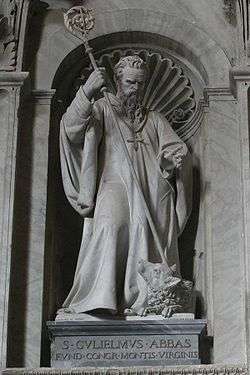William of Montevergine
| Saint William of Montevergine OSB | |
|---|---|
|
Saint William of Montevergine's statue at St. Peter's Basilica, Vatican | |
| Abbot | |
| Born |
1085 Vercelli, Italy |
| Died |
June 25, 1142 Sant'Angelo dei Lombardi, Italy |
| Venerated in | Roman Catholic Church |
| Feast | June 25 |
| Attributes | wolf; crosier |
| Patronage | Irpinia |
William of Montevergine, or William of Vercelli, (Italian Guglielmo) (Latin Gulielmus) (1085 – 25 June 1142) was a Catholic hermit and the founder of the Congregation of Monte Vergine, or "Williamites".
Life
He was born into a noble family of Vercelli in northwest Italy and brought up by a relation after the death of his parents. He undertook a pilgrimage to Santiago de Compostela. Catholic tradition states that on his pilgrimage to Compostela, William encircled his body with iron bands to increase his suffering.[1]
He then lived as a hermit on the summit of Monte Vergine (then known as Monte Vergiliana) between Nola and Benevento. Here he attracted a number of followers and founded the Monastery of Montevergine.
While at Montevergine, William of Vercelli is stated as having performed miracles.[1] Roger I of Sicily served as a patron to William, who founded many monasteries for men and women in Sicily. The Catholic Encyclopedia states that Roger built a monastery opposite his palace at Salerno in order to have William always near him.[1]
He died at Goleto, a daughter house of Montevergine near Nusco, province of Avellino. Catholic tradition states that William foresaw his own imminent death “by special revelation”.[1]
See also
References
- The Book of Saints, compiled by the Benedictine monks of St Augustine's Abbey, Ramsgate. London: Cassell, 1994. ISBN 0-304-34357-9.
- Guglielmo di Montevergine (da Vercelli) at the Santi e Beati website.
-
 This article incorporates text from a publication now in the public domain: Herbermann, Charles, ed. (1913). "article name needed". Catholic Encyclopedia. New York: Robert Appleton.
This article incorporates text from a publication now in the public domain: Herbermann, Charles, ed. (1913). "article name needed". Catholic Encyclopedia. New York: Robert Appleton.
Further reading
- Guglielmo di Montevergine (da Vercelli) at Santi e Beati (Italian)
